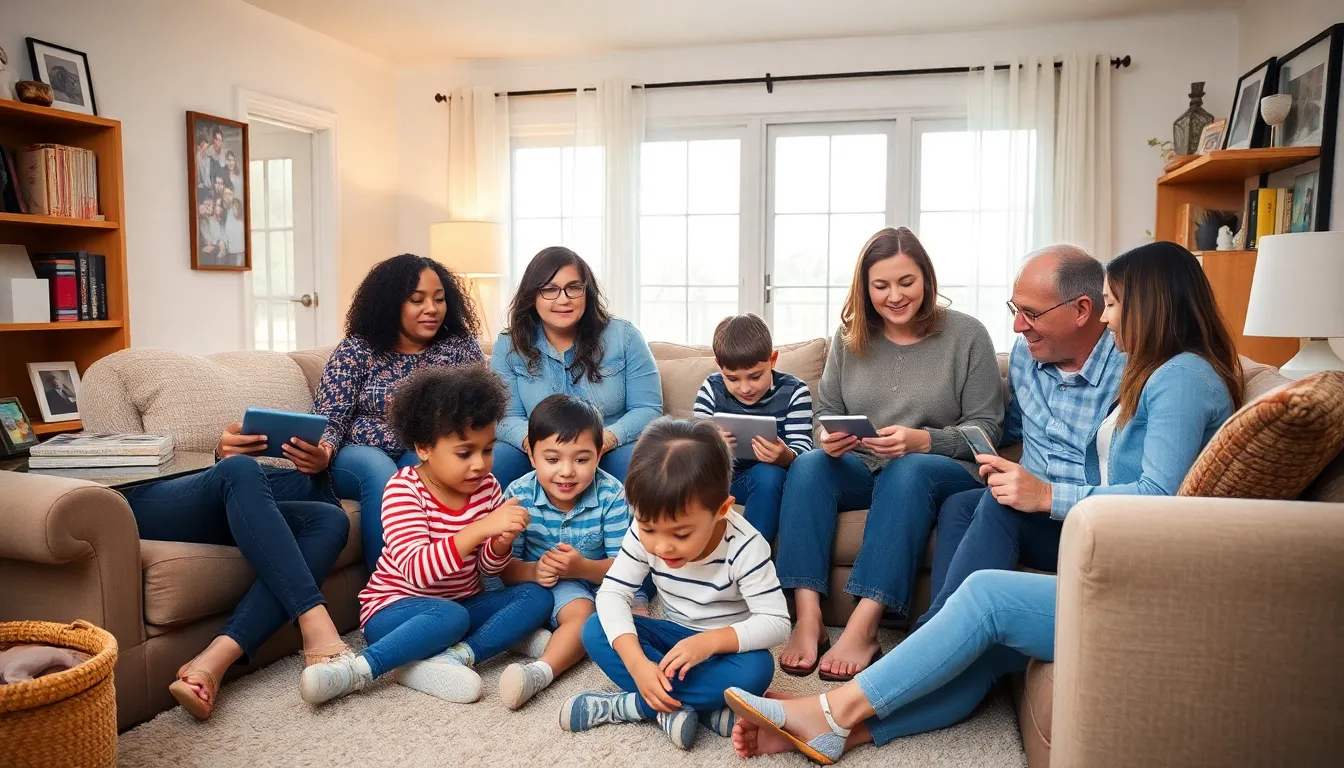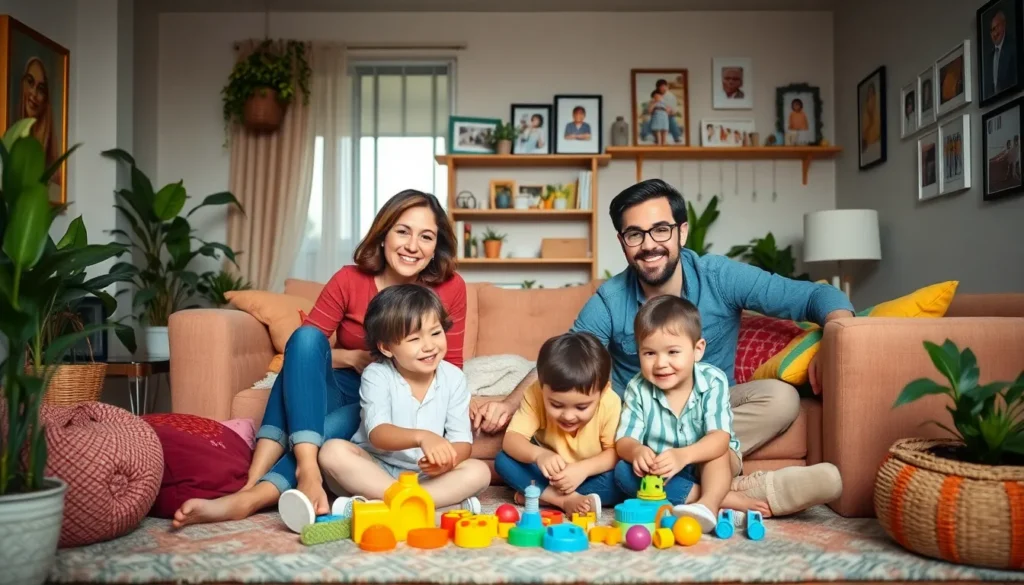Table of Contents
ToggleIn today’s fast-paced world, family dynamics are evolving at an unprecedented rate. Traditional structures are shifting, giving rise to diverse family configurations that reflect modern society’s values and challenges. From blended families to single-parent households and cohabiting couples, these new dynamics shape how families interact and support one another.
Understanding these changes is crucial for fostering healthy relationships and promoting emotional well-being. As roles and responsibilities within families transform, so do the expectations and communication styles. Exploring these new dynamics not only highlights the resilience of families but also emphasizes the importance of adaptability in navigating life’s complexities.
Understanding New Family Dynamics
New family dynamics encompass a variety of structures that reflect current societal changes. These dynamics include blended families, single-parent households, same-sex partnerships, and extended family living arrangements. Each configuration presents unique challenges and opportunities.
Blended Families
Blended families form when one or both partners in a relationship bring children from previous relationships into a new family unit. Successful integration requires effective communication among all members. Establishing clear roles and expectations helps to ease transitions and foster cooperation.
Single-Parent Households
Single-parent households often arise from divorce, separation, or the choice to raise children independently. These families face specific challenges such as financial strain and balancing work and family responsibilities. Support networks play a crucial role in providing emotional and practical assistance.
Cohabiting Couples
Cohabiting couples represent a growing family dynamic that involves living together without formal marriage. This arrangement often leads to complex family structures when children are introduced. Cohabiting partners must navigate shared responsibilities and establish a foundation for effective communication.
Extended Family Living Arrangements
Extended family living arrangements include multiple generations living together, such as grandparents, parents, and children. These living situations provide emotional support and financial benefits. However, they can also lead to conflicts over differing parenting styles and household management.
Communication Styles
Communication styles significantly influence how families operate. Open and honest communication fosters understanding and trust among family members. Families may adopt new communication methods, such as digital tools, to enhance connectivity, especially in blended and cohabiting environments.
Role Adaptability
Roles within families continue to evolve. Traditional expectations are replaced with more fluid dynamics based on preferences and strengths. Family members must be adaptable, allowing for the reshaping of responsibilities to meet the needs of the family unit.
Emotional Well-Being
Emotional well-being is essential for all family members. Understanding and respecting individual feelings help to create a nurturing environment. Support systems within the family framework can enhance resilience and contribute to overall happiness.
Recognizing these new family dynamics allows for a better understanding of relationships and promotes a harmonious living environment. Adaptation to changes in structure and communication is key to thriving in modern family life.
Factors Influencing New Family Dynamics

New family dynamics are shaped by various factors, including cultural shifts and technological advances. These influences contribute to the evolving landscape of family structures and relationships.
Cultural Shifts
Cultural shifts significantly affect family dynamics. Changing societal norms promote acceptance of diverse family configurations, leading to blended families, same-sex partnerships, and single-parent households. Increased visibility of LGBTQ+ families encourages openness and dialogue surrounding different family types. Migration patterns create multicultural households, blending traditions and values from various backgrounds, which enrich family life. Additionally, changes in gender roles empower individuals to share responsibilities, reshaping expectations regarding parenting and household management. These cultural changes foster resilience and adaptability, enhancing family relationships in today’s world.
Technological Advances
Technological advances play a crucial role in transforming family dynamics. Communication technologies, like smartphones and social media, facilitate instant connectivity, allowing family members to maintain relationships despite physical distances. Access to online resources empowers families to seek support, information, and community, broadening their networks. Parenting apps and platforms offer practical advice and skills, reducing stress and enhancing parenting experiences. Virtual gatherings enable families to stay connected during challenging times, such as the COVID-19 pandemic. As technology continues to evolve, its impact on communication, parenting, and family cohesion remains significant, shaping the future of family life.
Impact of New Family Dynamics
New family dynamics significantly influence relationships, parenting, and the roles individuals assume within the family unit. Understanding these impacts allows families to adapt and thrive in a changing environment.
Changes in Parenting Styles
Changes in parenting styles reflect a shift toward more collaborative approaches. Modern parents engage in shared decision-making, where both partners actively participate in parenting tasks, from handling finances to managing children’s education. This collaborative style promotes emotional intelligence among children by modeling cooperation and negotiation skills. Increased access to parenting resources also empowers parents to adopt innovative techniques tailored to their children’s individual needs.
Evolving Gender Roles
Evolving gender roles redefine expectations within families. Traditional roles often placed mothers as primary caregivers and fathers as providers. Now, it’s common for both parents to share responsibilities, regardless of gender. This shift encourages a more equitable distribution of household chores and parenting duties, allowing each family member to develop diverse skills. Increased participation of fathers in caregiving leads to stronger emotional bonds with children and promotes gender equality, benefiting the entire family structure.
Challenges of New Family Dynamics
New family dynamics present several challenges that can impact relationships, communication, and emotional well-being. Understanding these obstacles fosters better adaptability and resilience.
Communication Barriers
Communication barriers often hinder effective interaction within diverse family structures. In blended families, differing communication styles can create misunderstandings. For instance, children from previous relationships may struggle to accept a stepparent’s authority, complicating dialogue. In cohabiting couples, lack of clear expectations can lead to frustration. Establishing common ground through regular family meetings cultivates open communication. It ensures all members voice their thoughts and feelings, ultimately enhancing understanding.
Societal Pressures
Societal pressures significantly affect how families navigate their dynamics. Families may feel compelled to adhere to traditional norms despite existing diverse structures. This pressure can heighten stress, particularly for single-parent households and same-sex partnerships. Additionally, unrealistic portrayals of family life in media may foster dissatisfaction. Acknowledging these societal influences helps families construct their identities authentically. Embracing uniqueness allows families to focus on their internal dynamics rather than external expectations.
Embracing New Family Dynamics
New family dynamics present opportunities for growth and connection. Families adapting to these changes can utilize specific strategies to foster resilience and create harmonious relationships.
Strategies for Adaptation
- Open Communication: Encourages families to establish open dialogues, allowing members to share feelings and concerns. Regular discussions can address misunderstandings and promote trust.
- Clear Roles and Responsibilities: Helps families define each member’s roles, enhancing cooperation and reducing conflicts. Clarity in responsibilities fosters accountability and smooth functioning.
- Shared Decision-Making: Engages all family members in decision-making processes, cultivating a sense of belonging and respect. Involvement enhances collaboration and reinforces family unity.
- Flexibility: Promotes adaptability in responding to changing circumstances. Being open to adjustments in routines or roles allows families to navigate transitions more effectively.
- Support Networks: Encourages families to build connections with extended family and friends. Strong support systems provide additional resources, advice, and emotional assistance in challenging times.
Building Resilience
- Emotional Support: Establishes a foundation for emotional well-being by creating a safe space for expressing feelings. Support from family members strengthens bonds and fosters a nurturing environment.
- Problem-Solving Skills: Equips families with the tools needed to confront challenges collaboratively. Collaborative problem-solving develops critical thinking and enhances resilience.
- Shared Values and Goals: Unites families under common principles and aspirations. Identifying and pursuing shared values promotes cohesiveness and common purpose.
- Healthy Boundaries: Ensures individual needs are respected while maintaining family connections. Establishing boundaries fosters independence and mutual respect among members.
- Celebrating Milestones: Encourages families to acknowledge achievements and special occasions. Celebrating milestones reinforces positive experiences and strengthens family ties.
Navigating new family dynamics requires understanding and adaptability. As families evolve, they face unique challenges but also incredible opportunities for connection and growth. Embracing open communication and collaboration fosters healthier relationships and emotional well-being among family members.
By acknowledging the diverse configurations of modern families, individuals can build resilience and cultivate supportive environments. Adapting to changing roles and responsibilities not only strengthens bonds but also promotes a sense of belonging. In this ever-changing landscape, families can thrive by focusing on their unique dynamics and prioritizing emotional support and shared values.





